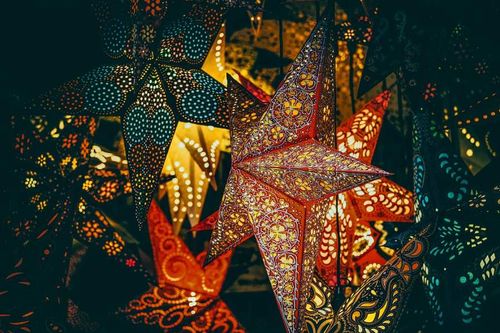Christmas in Mexico: Festive Celebration of Faith and Family
Mexicans celebrate Christmas (Navidad) with great joy and devotion each year from December 12th through January 6th with their unique cultural traditions, delicious foods, and festive events. Across this deeply Catholic country, these cherished holidays center around faith, food, and family.
Vibrant decorations and festivities can be seen everywhere during “Guadalupe-Reyes” season, as Mexicans honor the Virgin of Guadalupe feast day (December 12th) all the way through Three Kings Day (January 6th). Mexicans especially love to decorate their homes, churches, town squares and more with bright colors and elaborate nativity scenes known as “nacimientos.”
In this extensive guide you’ll discover:
- Key dates for Christmas celebrations & traditions
- Beautiful and meaningful decorations
- Special masses, processions & reenactments
- Signature holiday dishes & drinks
- Traditional Christmas Eve dinner menu
- Fun games, fireworks & events
- Exchanging gifts on Christmas morning
- Gatherings with family & friends
- Ending the holidays on Three Kings Day With insight into historical and religious roots, you’ll gain a deeper understanding of the vibrant Navidad festivities so integral to Mexican culture.

Nacimientos & Farolitos Set the Scene for Navidad Beautiful decorations burst onto the scene by December 12th, as captivating nativity scenes known as nacimientos take centerstage across Mexican homes and churches. Using moss, rocks, wood, clay figurines and more to create stunning miniature landscapes and structures, Mexicans honor the humble birth of Jesus with elaborate artistry...
The Long-Awaited Feast of the Virgin of Guadalupe In a country where over 80% of the population identifies as Catholic, the feast day honoring the Virgin of Guadalupe holds deep meaning. Known as “La Morenita” (the brown-skinned Virgin), legend tells of her miraculous appearance in Mexico in 1531...
Las Posadas Reenacts the Pilgrimage to Bethlehem For nine straight evenings leading up to Christmas, communities across Mexico take part in a beloved reenactment of Mary and Joseph seeking shelter in Bethlehem called Las Posadas. Meaning “the inns” or “lodging”, neighbors play the roles of pilgrims and innkeepers with songs, prayers, breaking piñatas and festive parties afterwards...
Traditional Christmas Eve Dinner
Nochebuena Menu for the Traditional Christmas Eve Dinner. The crowning feast of the season is the sumptuous Christmas Eve dinner called Nochebuena. Families gather together in their finely decorated homes on the night of December 24th for this treasured meal overflowing with symbolic dishes...
Midnight Mass & Fireworks Usher in Navidad As the clock approaches midnight, church bells resound across Mexico’s cities and pueblos calling families to La Misa del Gallo (Midnight Mass)...

Gifts from Baby Jesus Appear on Christmas Morning The wait is finally over on Christmas morning as wide-eyed children awake to gifts from Baby Jesus (Niño Dios) under the decorated tree. Families enjoy a relaxed morning opening presents wrapped in colorful paper and sharing the leftovers from Nochebuena...
New Year’s Eve Traditions for Good Luck As the year draws to an end, Mexican families observe fun traditions to attract good fortune, blessings, prosperity, health and more for the upcoming year. Many rituals involve themes of new beginnings, renewal, and clearing out the old to make room for the new...
Rosca de Reyes Bread Takes the Spotlight on Three Kings Day The Christmas season officially ends on January 6th with the grand feast of Three Kings Day known as Día de Los Reyes marking the day the Three Wise Men arrived bearing gifts for baby Jesus. The star of this highly anticipated holiday is the wreath-shaped bread called Rosca de Reyes ...
FAQs: Common Questions about Christmas in Mexico
What are the key dates for Christmas celebrations in Mexico? Christmas festivities span several weeks in Mexico, beginning December 12th through January 6th. Key dates include:
- December 12 - Feast of Virgin of Guadalupe
- December 16 to 24 - Las Posadas celebrations
- December 24 - Christmas Eve (Nochebuena)
- December 25 - Christmas Day (Navidad)
- December 31 - New Year’s Eve (Nochevieja)
- January 6 - Three Kings Day (Día de los Reyes)

When do Mexicans decorate for Christmas and what’s it like? Elaborate decorations adorn homes, churches and streets starting December 12th for the feast of the Virgin of Guadalupe. Bright farolito lanterns line roofs, sidewalks, and plazas while nacimientos (nativity scenes) prominently display the story of Jesus’ birth. Christmas trees dressed with colorful ornaments and strands of tinsel are also popular.
What foods & drinks are traditionally served at the Christmas Eve dinner? The Nochebuena menu overflows with culinary delicacies like roast turkey mole, bacalao (salt cod), romeritos (shrimp dish), tamales, pozole, ponche (fruit punch), bunuelos (fritters) and more. Dishes carry symbolic meaning from bounty and blessings to commemorating the nativity story.
How long do Mexicans typically celebrate Christmas? From the Virgin of Guadalupe celebrations on December 12th all the way through Three Kings Day on January 6th, Mexicans celebrate Christmas with great devotion for about 3 weeks. The deeply religious culture places immense importance on the long-awaited birth of Jesus.
What gifts do Mexican children receive for Christmas? On Christmas morning, children awake to gifts from Niño Dios (Baby Jesus) left under the decorated tree while they slept. Common presents include bikes, baby dolls, action figures, stuffed animals, toy cars, board games, clothing and shoes.
Do Mexicans celebrate New Year’s Eve? What are the traditions? Ringing in the New Year, known as Nochevieja, is hugely popular across Mexico. Families observe fun traditions to attract good luck for 2023 like eating 12 grapes at midnight, wearing yellow underwear, tossing a bucket of water out the doorway and more. Festive parties, fireworks and street celebrations abound in cities like Mexico City, Oaxaca and Mazatlán.
What happens on Three Kings Day in Mexico? As the culmination of the Christmas season, January 6th honors the Three Wise Men (Los Reyes Magos) who arrived bearing gifts for Baby Jesus. Children excitedly leave their shoes out the night before to find them filled with presents the next morning. Families then gather to share the Rosca de Reyes - a wreath-shaped sweetbread hiding a small figure of baby Jesus inside. Whoever finds it hosts a tamales feast on February 2nd for Candelaria Day.
People Also Ask: More Queries about Mexican Christmas Celebrations
When should I book flights and hotels to Mexico for Christmas? Book very early, ideally 4-6 months in advance. The weeks around Christmas and New Year’s are Mexico’s peak tourist season. Hotels, flights and tours fill up fast, especially in popular destinations like Mexico City, Oaxaca, San Miguel de Allende and the coastal resort towns.
What’s the weather like in Mexico during Christmas? Mexico’s a huge country stretching across different climate zones. December and January see pleasant dry seasons and warm temperatures (mid 70s°F - mid 80’s°F) along the coastal resort areas of Puerto Vallarta, Cancun, Cabo, and the Mayan Riviera with cooler weather in central colonial highlands like San Miguel de Allende. Some rain is common on both coasts too. Pack layers!

What are the most festive places to spend Christmas in Mexico? The most vibrant Navidad celebrations abound in iconic destinations like Mexico City with its spectacular plazas and churches, Oaxaca’s rich cultural scene, San Miguel de Allende’s charming colonial atmosphere or along the sparkling Mayan Riviera beaches.
Is Christmas Eve or Christmas Day more important in Mexico? Without question, the very important Christmas Eve dinner (Nochebuena) on December 24th takes precedence with its abundance of symbolic dishes honoring Mexico’s Catholic faith and important family time. Relaxed Christmas day follows to finish exchanging gifts, enjoy leftovers and savor quality time together.
What traditional Mexican sweet bread is eaten at Christmas? Several iconic sweetbreads grace Mexican holiday tables. Savory-sweet tamales wrapped in corn husks date back millennia. France-influenced bûche de Noche (Yule log) rolls out in December along with star-shaped pieces. Rosca de Reyes bread takes the spotlight on Three Kings Day with its oval wreath shape hiding a baby Jesus figurine inside.
What are Los Reyes Magos? Do Mexicans have Santa? Rather than Santa, Mexicans honor Los Reyes Magos - the Three Kings or Wise Men bearing symbolic gifts for baby Jesus. The three Biblical kings named Melchor, Gaspar, and Baltazar ride on horseback during “dia de reyes” parades on January 6th when children also excitedly receive gifts in their shoes left by the Three Kings while they sleep.
Why are nativity scenes so big & elaborate at Mexican Christmas? In this devout, largely Catholic culture, nacimientos beautifully recreate Jesus Christ’s birth with incredible detail to honor one of the most holy, celebrated moments in their faith. Using moss, rocks, wood, plaster and more to construct stunning miniature structures and landscapes housing figures straight from Bible accounts makes Christmas incredibly meaningful.
What traditional dances perform during Christmas season? Festive dancing abounds during posadas celebrations in the weeks before Christmas! Mexicans and those portraying Mary & Joseph perform beautiful dances named matachines along the posada processions in indigenous dresses. People also dance with gusto after breaking the star-shaped piñata.
What Christmas dishes should visitors avoid eating? Adventurous eaters should sample classic fare like tamales or bacalao without worry! However, be cautious with raw seafood like ceviche, uncooked vegetables, unpasteurized cheese, or street food with less stringent hygiene standards. Stick to purified water as well. When in doubt, opt for gentle cooked dishes.

Vibrant Festivals & Traditions You Won’t Want to Miss
Festival of Lights in Mexico City’s Zócalo As one of Mexico’s most celebrated public Christmas displays, the Festival of Lights transforms the heart of Mexico City into a glittering winter wonderland. Over 200,000 LED lights bedeck towering Christmas trees and buildings encircling the massive main plaza known as the Zócalo...
Christmas Majitas Fair in San Miguel de Allende In this beloved colonial town flooded with Christmas charm, the majestic La Parroquia church dons strands of tiny white lights alongside the main plaza. The adjacent streets hold brightly lit food stalls at the Christmas Majitas Fair selling local handicrafts and traditional holiday foods among live musicians. It’s magical!
Fiesta de Santo Reyes in Tixtla, Guerrero The small rural town of Tixtla hosts a grand Three Kings Day celebration on January 6th welcoming the Biblical Wise Men in style with an elaborate parade. Colorful floats carry costumed children throwing candy, a live camel, marching bands and dancing horses down the main avenue into the decorated central plaza.
Sea Turtle Releases on Christmas Eve In a beautiful show of conservation, many coastal communities along both the Pacific and Caribbean coasts organize sanctioned releases of vulnerable baby sea turtles on Christmas Eve. Locals and visitors may sponsor, name and release infant turtles bearing a special holiday message into the wild under starlit skies.
Unique Regional Traditions
In Sierra Tarahumara, indigenous Raramuri display incredible running feats by doing non-stop kickballs across mountain trails for days during Navidad festivals. Villagers in Oaxaca jump over small bonfires on Christmas Eve in a fiery tradition meant to purge illness and misfortune from their bodies. And on Christmas mornings, kids in northern states stage lively Matlachines dances dressed in colorful masks and skirts imitating Spain’s Moors and Christians battle.
Across Mexico’s diverse regions, communities infuse local flare into familiar Navidad traditions. But universally, the holiday centers around cherished time with family savoring special meals filled with symbolic meaning to honor baby Jesus.
Plan an Unforgettable Mexican Christmas Vacation
With its unique blend of distinctive cultural traditions, deep spiritual rituals, lively festivals, delicious cuisine and warm hospitality, Mexico shines as a top destination for Christmas. Use this overview as your guide to experiencing a truly memorable Mexican Navidad. Discover folk arts like elaborate nacimientos, shop vibrant Christmas bazaars, and stay at a beautiful hacienda or resort sparkling with farolitos. Wander colonial churches glowing in holiday splendor then feast on mole and ponche navideno late into the night. Feliz Navidad!





